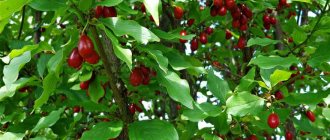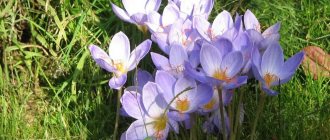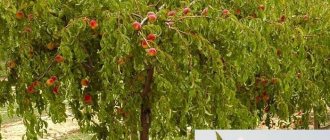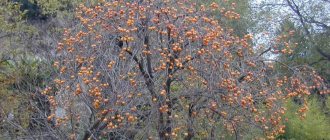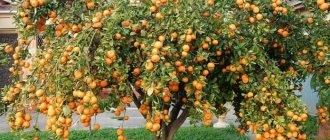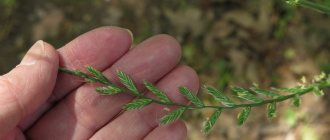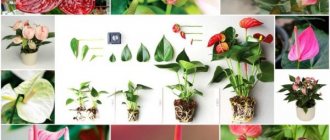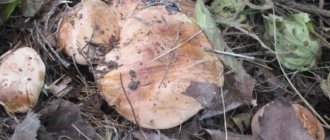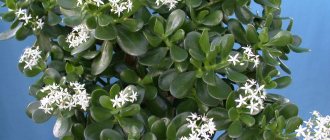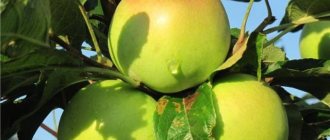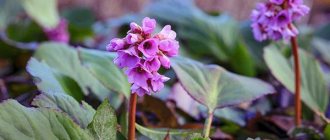Loading…
Loading…
Bright orange fruits, which appear on shelves only in late autumn and winter, cannot be seen in the gardens of the middle zone. How do persimmons grow? Where is the birthplace of this plant, and what are the features of its cultivation?
The usual, native habitat for persimmons is the subtropics and tropical regions of Asia. An extensive genus of deciduous trees belonging to the Ebony family includes more than seven hundred species, which are distributed from China and Transcaucasia to Malaysia.
Where do persimmons grow?
Man has long appreciated the taste of ripe persimmon, and today various varieties of the plant are cultivated all over the world, where climatic conditions allow. Thanks to selection and the emergence of frost-resistant seedlings, persimmon has significantly expanded its natural range. A culture with a long growing season has found a place in gardens in southern Europe, on the North American continent, in Japan and Australia.
Sweet fruits most often come to Russian stores from Turkey, Israel, the countries of Transcaucasia and the North Caucasus, where from time immemorial cultivated trees of a local, rather unpretentious species have been grown.
Since the beginning of the last century, the cultivation of persimmons has been established in Crimea. A plantation of a valuable fruit crop has been established in the Nikitsky Botanical Garden. Serious scientific work was also begun here to develop new winter-hardy varieties adapted for Russian conditions.
Among the achievements of Crimean breeders are the Rossiyanka and Nikitskaya Bordovaya varieties, which successfully bear fruit on the peninsula and withstand cold temperatures down to –25 °C without much loss. These varieties made it possible to grow persimmons in Ukraine.
What does a persimmon tree look like, flowers and leaves
The plants that make up the Persimmon genus are fairly large, long-lived trees, which in favorable conditions reach a height of 8 meters and an age of 500 years. Cultivated varieties retain the characteristics of their wild ancestors. The trees have a wide spreading crown with long drooping branches.
A peculiarity of the culture is the presence of male and female plants, externally differing in the shape and nature of the flowers. Therefore, to increase productivity, several pollinators are planted near the plantation with fruit-bearing trees. You can find out how persimmon blooms from the photo. Female, single flowers are distinguished by wide sepals and the shape of a corolla with a diameter of up to 2–3 cm.
Male flowers sit on the shoots in a cluster, sometimes in small inflorescences of 2–5 pieces. They have a narrower, glass-like shape and yellowish-white petals. In different regions, persimmon flowering can begin from March to May.
Simple leaves up to 7 cm long, alternately sitting on the shoots, can be recognized by:
- oval-heart-shaped;
- by light green color, becoming darker as it grows;
- smooth surface with a clearly visible network of veins.
In autumn, the trees turn yellow and red. At the same time, falling leaves have virtually no effect on the appearance of the persimmon tree, because all the branches are covered with orange, yellow and almost red fruits.
Appearance of persimmon
Date plum or persimmon is a woody plant of the Ebony family. In the wild it can reach 14 meters in height. At home, the size of the tree rarely exceeds 2 meters. Their growth is usually controlled by timely pruning. The fruits are large, fleshy, bright orange or red. The interesting pattern of the bark and the bends of the branches make it possible to grow persimmon as an ornamental plant. Dark green leaves create an openwork crown. Closer to leaf fall, their color can change from green to red.
Interesting! In addition to persimmons, on the shelves you can find fruits such as kinglet and sharon. The wren is a berry grown from male flowers. It differs from simple persimmon by the presence of seeds in the pulp, the absence of an astringent effect and the brownish pulp. Sharon is a hybrid of persimmon and apple. You can recognize this berry by its thin skin and denser pulp.
Features of persimmon fruits
For those interested in how persimmons grow, it will be useful to know a little information about its fruits. In place of the female flowers, at the end of flowering, a green dense ovary is formed, inside which there can be up to 10 large elongated seeds. As the fruits ripen, they acquire an oval, pointed or rounded heart-shaped shape. There are varieties with flattened berries.
Depending on the variety and type, the color of ripe persimmon also changes, ranging from light yellow to almost brown. Ripening begins in September and continues until December, so when persimmons are grown in the Crimea, North Ossetia and Ukraine, they sometimes end up under snow.
Most often, Oriental, Caucasian and American persimmons are grown in gardens. Varieties with sweet, non-astringent fruits are especially popular among gardeners and consumers.
Anyone who loves the sweet taste of persimmons knows that the fruits are divided into two categories.
- The first ones are tasty even if they are not too ripe. They have soft flesh without pronounced fibers, which becomes jelly-like in ripe fruits.
- In the second category of persimmon, the fruits become edible only after falling under the first frost or artificial freezing. The pulp of these varieties is coarser and contains more fiber.
Both varieties have their pros and cons. Persimmons with soft, delicious fruits do not tolerate long-term storage and transportation. The slightest damage to the skin threatens rapid spoilage. Hard, astringent fruits can be stored for up to 30–40 days, and then after exposure to sub-zero temperatures, enjoy a healthy delicacy.
How to get the fruits
Most persimmon varieties are dioecious. This means that flowers of only one sex bloom on one tree. In order to get a harvest, you will need to carry out pollination between two plants of different sexes.
You can distinguish male flowers from female ones by their appearance. The first ones are small, collected in small inflorescences. Female flowers are large with a tart aroma and fleshy petals. Flowering occurs in mid-June, at the same time pollination takes place. To do this, a clean, dry brush with soft bristles is first passed over the male inflorescences, and then over the female ones. If everything is done correctly, after 1-2 weeks you can see the first ovaries. Full ripening of the fruit occurs by the end of October - beginning of November.
The first fruiting of a young seedling can be expected 5-6 years after planting. To reduce this period, gardeners vaccinate persimmons. The conditions for the procedure are a trunk thickness of at least 5 mm and a height of at least 15 cm. Fruit-bearing varieties of persimmon are used as a scion. It is not recommended to graft the plant onto other crops, as this may lead to a complete loss of the harvest in the future.
How persimmon grows: requirements for open ground
In nature, persimmon grows in warm regions with a long warm period of the year. Modern frost-resistant varieties have made it possible to push back the northern limit of comfortable growth to the southern regions of Russia. How to grow persimmons in your garden?
Observing how persimmon grows in Crimea, on the Black Sea coast of the Caucasus and Ukraine, in northern Ossetia, you can notice that trees in open ground prefer well-lit areas with protection from wind and flooding in the spring and autumn.
The culture is undemanding to the type and composition of the soil, while it can react to excess organic matter by dropping the already formed ovary. The main thing is that the powerful root system receives enough air and moisture.
If persimmons find themselves in arid conditions, the quality of the crop deteriorates; prolonged moisture deficiency causes the ovary and foliage to fall off.
In regions where persimmon grows in natural conditions, the trees bloom already in the warm season, and the fruits have time to fill and practically ripen before serious frosts. To the north, persimmons need protection from freezing and the danger of spring rain. This applies to both fruit-bearing trees and plants grown for decorative purposes.
To prevent harvesting from a tree 6–10 meters high from turning into a risky adventure, the persimmon crown begins to be formed from the first years after planting. In addition to limiting growth, they prune young, too thin branches, which often cannot withstand the weight of the fruit and are the first to freeze in cold winters.
Stages of growing persimmons at home
Let us immediately warn you that it is extremely important for this tree to provide a comfortable microclimate. Persimmon grows well in high humidity and good light. In summer, she needs warmth and abundant sunlight, and the best place for her wintering is a cellar or a glassed-in balcony. Frost and heat are destructive for her. If the tree grows in a summer cottage, do not forget to bring it into the house during the first frost.
Anyone who is interested in floriculture and likes to experiment should simply try growing persimmons from seeds. We offer you detailed instructions.
Seed preparation
Ideally, take seeds from overripe fruits that remain on the tree until late autumn. But most often the seeds are the seeds from the eaten fruit. Then you should choose the most ripe fruit. Whether the seeds will grow into a healthy, strong plant largely depends on how correctly the seeds are prepared for planting.
- Take several seeds at once, because not all can sprout. They should be thoroughly washed with water at room temperature, and then dried in natural conditions, not in the sun.
- The seeds may contain bacteria and fungus, so before planting they should lie in a weak solution of potassium permanganate for two days.
Selecting persimmon seeds for planting
It is not possible to plant seedless persimmons from self-pollinating varieties. Requirements for the fruit: maturity, softness, absence of damage. Frozen fruit is not suitable for seed material: the seeds are not viable.
Not fully ripened berries are left to ripen, placed in a warm place near a heating radiator on the windowsill. You can remove the seeds from the fruit when the skin cracks and the sepals dry out.
The fruit seeds are washed and dried well. Next, they are kept in a weak solution of potassium permanganate for 2 days. Seeds that have sunk to the bottom are suitable for planting. Bones that float on the surface are not suitable for planting.
Next they deal with stratification. The planting material is treated with a growth stimulator, placed in a napkin, and sent to the bottom shelf or behind the refrigerator door for 1.5–2 months. Storage is carried out at t=+5 °C. Periodically, the napkin needs to be moistened.
When the seeds are taken out of the refrigerator, they are kept in a warm place for a couple of days. Treatment is carried out with a plant growth stimulator using Silk, Zircon, Epin.
Planting is accompanied by scarification: the ribs of the seeds are filed with sandpaper. The operation is responsible for rapid germination. It is advisable to immerse the seed material for disinfection in potassium permanganate for 30 minutes before planting.
Seed treatment
Having selected the grains suitable for sowing, whole and undamaged, they should be prepared. First, the juice is washed off. Then immerse for several minutes in life-giving moisture. Those that float are thrown away, the remaining ones are dried on a napkin.
Disinfection affects the successful germination of seedlings. After washing, immerse the seeds in a weak solution of manganese for a day. To speed up pecking, carefully go over the ribs with soft sandpaper or a glass manicure file.
Choosing soil
You need to take light soil. It will allow moisture to pass through well. If the soil is heavy, water will stagnate in it and the seed may rot. It is better to mix peat and garden soil in half. Such soil will have optimal drainage properties.
Planting persimmon seeds
For those who have grown plants from seeds or ordinary seedlings, this will not be the slightest difficulty. And for those who have already grown a date from a seed or a lemon from a seed, the process will seem completely familiar.
The earthen mixture for germinating persimmon seeds should be light and freely permeable to water and air. Any peat-based soil, diluted by a third with perlite or vermiculite, will do. How to place persimmon seeds on the surface of the soil is shown in the photo. After this, they are sprinkled with a thin (up to one centimeter) layer of the same soil.
After planting, the container with the planted persimmon seeds should be placed in a warm, dark place for germination. First cover the container with a piece of glass, transparent plastic or regular plastic film. As practice shows, a good place for germinating persimmon seeds is on the floor near a heating radiator or on the down pipe of the same radiator (if it is not very hot!). This place is both warm and quite dark. The entire process of germination of persimmon seeds can take up to a month, but during this entire time it is necessary to periodically check their condition, ventilate, remove condensation from the cover, and moisten the soil if necessary.
Germination process
Now the most important thing is to be patient. In just a couple of weeks, the first green shoots should appear. Do not forget to ventilate the pots every 2-3 days. The cellophane will need to be removed for 30-60 minutes. Otherwise, the surface of the earth may become covered with fungus. If the soil requires it, it should be watered a little. But don’t overdo it, because seeds won’t germinate in a swamp either.
As soon as you see sprouts appear, feel free to remove the film. When they have three leaves, we transplant them into new soil. Be sure to remove any remaining seed flaps from the sheets. If you can't do it with your hands, use nail scissors or a needle.
This is interesting: How to save Geranium if its leaves turn yellow - causes and prevention
The second option for germination is in cotton wool. Each bone is separately wrapped in a layer of damp cotton wool and placed in a plastic bag. Place the packages in a warm place. Once every 2-3 days they should be opened to ventilate. It is important to regularly moisten the cotton with water to prevent it from drying out.
Transplantation and substrate
It is always best to replant both young plants and older persimmons after the roots have completely filled the substrate. Transplantation of this fruit-bearing plant can only be carried out in the spring, at the beginning of the active growth phase. Usually, indoor persimmons are transferred and replanted in February-March.
For indoor persimmons, you can choose any universal substrate. Loose, not prone to compaction, breathable soil with a slightly acidic or neutral reaction is quite suitable for it. Of the purchased substrates, soil for rhododendrons is considered optimal in structure. If you prepare the soil yourself, then mix humus or compost, turf soil and peat in equal parts, adding sand, wood ash or bone meal to correct the texture.
The transplantation process for persimmons must be very careful. The rhizome of the plant is not exposed; the earthen ball is completely preserved and the plant is simply transferred to large pots.
It is advisable to grow indoor persimmons with soil mulching. Decorative filling, bark, and sawdust will help stabilize humidity and protect the plant from overheating, hypothermia, and drying out of the soil.
Growing the plant correctly
It is important to know the conditions for growing persimmon well and strictly follow them.
- In summer, the future tree should be placed in a well-lit area on the balcony or in the yard. Accustom it to the sun gradually, otherwise the leaves may burn.
- In summer, persimmons feel best in the garden. If you live in an apartment, find a well-lit place on the balcony without drafts.
- Remember about feeding. During the growing season, nitrogen-free fertilizers should be applied twice a month.
- The plant loves good watering and spraying. But do not over-moisten the soil, as the root system may rot.
- Protect the tree from drafts. If you take into account these simple care features, you are guaranteed a successful result.
So, the list of basic conditions for keeping persimmons is as follows:
- water generously, but do not overwater;
- spray to create sufficient humidity;
- Fertilize in the summer twice a month with nitrogen-free fertilizer;
- for a permanent place, choose a lighted area;
- during wintering the temperature should not fall below +10;
- Replant the plant in a larger pot every spring.
Pollination
The persimmon plant produces the following types of flowers:
- men's;
- women's;
- bisexual.
Some varieties are characterized by the formation of only female flowers:
- Aizumishira
- Tsuru;
- Russian;
- Gosho gaki;
- Nikitskaya burgundy.
If the conditions of agricultural technology are followed, fruits are formed without fertilization. Some varieties produce both flowers every year in large quantities:
- Nakhodka;
- New.
- Satellite;
- Dream.
Among the varieties of persimmon there are:
- Pollinated: Tiedimon, Huro kuma, Tsurunoko, Maru Geili.
- Without pollination: Costata, Seedles, Gosho,
- Transitional group: Emon, Soyo, Adreula.
Pollination has a significant effect on fruit pulp viscosity and mouthfeel. Fruits with seeds are tastier than those without seeds. In a fruit that contains 1-2 seeds, the pulp is softer and much tastier compared to the seedless half. Fertilization of persimmon flowers determines both the yield and quality of orange berries.
When starting a persimmon garden, it is advisable to plant a pollinator on 8-9 trees. If there is no possibility of planting a pollinator, processing of persimmon flowers will be necessary. After the fruits have set, when they are dropped, they must be sprayed with an aqueous composition of gibberellin.
Ripening time
Fruits are harvested depending on the varietal variety:
- early: in the southern regions - mid-September - second ten days of October;
- mid-season - from October to the first days of November;
- late - from November 15 until December. The weather affects the ripening time. They vary: removal is possible ahead of time, ripening is carried out while lying down, worsening the taste slightly.
Wintering indoor persimmons grown from seeds
The tree must be wintered at a temperature of 5-10 °C, and the plant begins to prepare for winter dormancy in October, gradually reducing the frequency of watering. In winter, water rarely, making sure that the earthen ball does not dry out completely.
The approximate irrigation regime is once a month. Lighting does not play a role at this time. In early March, they begin to increase the frequency of watering. During the fruiting period, grafted seedlings enter 3-4 years of cultivation.
Spring transshipment and pinching
- In mid-February - early March, transfer the plant from the old pot and expose it to the light. Don’t forget to pinch at a distance of 0.3-0.5 m. This will help the tree to form correctly and send out branches.
- Leave 3 apical shoots. When they grow 30 cm, they also need to be pinched. This is how the branches of the second row are formed.
How to grow persimmons yourself?
Becoming the owner of your own fruit-bearing tree on your property is quite simple. To do this, you should purchase a frost-resistant persimmon seedling, plant it and take care of it until bright, ripe fruits appear.
Persimmon can be propagated by growing it from the seed of a ripe fruit. Unfortunately, seedlings do not retain varietal properties, so the plant will need grafting to produce abundant fruiting and produce sweet berries.
The best rootstock is considered to be Caucasian persimmon, which is characterized by increased winter hardiness, undemandingness to soil and endurance. The tree has a powerful fibrous root, thanks to which the plant can easily transfer to a larger pot. In the spring, when the trunk reaches a thickness of 1 cm, a cultivar of any type can be grafted onto a strong seedling. It is convenient to inoculate an additional pollinator on a grown tree.
In most of Russia and the Moscow region, growing persimmons in open ground is problematic. A short summer is not enough for the fruits to set and ripen; during and after flowering there is a high risk of frost, and in winter the frosts are too strong even for resistant Crimean varieties. Therefore, it is better to grow persimmons in pots. In this case, a tree up to one and a half meters high is easy to care for and with good care, even get a good harvest.
Useful properties of persimmon
Persimmon contains a large amount of useful substances and minerals. The amount of iron, calcium and manganese in this berry is several times higher than in apples. The high content of vitamin C makes persimmon a tasty remedy for the prevention and treatment of colds. There is more beta-carotene in fruits than in pumpkin, tomatoes and sweet peppers. This substance helps improve vision, complexion, and reduces the harm from nicotine use.
Persimmon contains a large amount of dietary fiber, which helps remove toxins from the body. This berry is an ideal product for those who are on a diet. It perfectly satisfies hunger and at the same time has low calorie content. There are only 70 kcal per 100 grams of product.
Magnesium, contained in the pulp of the fruit, helps strengthen the nervous system, helps fight depression and fatigue.
Helpful information
Daria Vorontsova
Amateur gardener. He is interested in growing various greens at home.
The astringent effect of persimmon is more pronounced in unripe fruits. You can get rid of it by putting the berries in the refrigerator or next to the apples for several hours.
